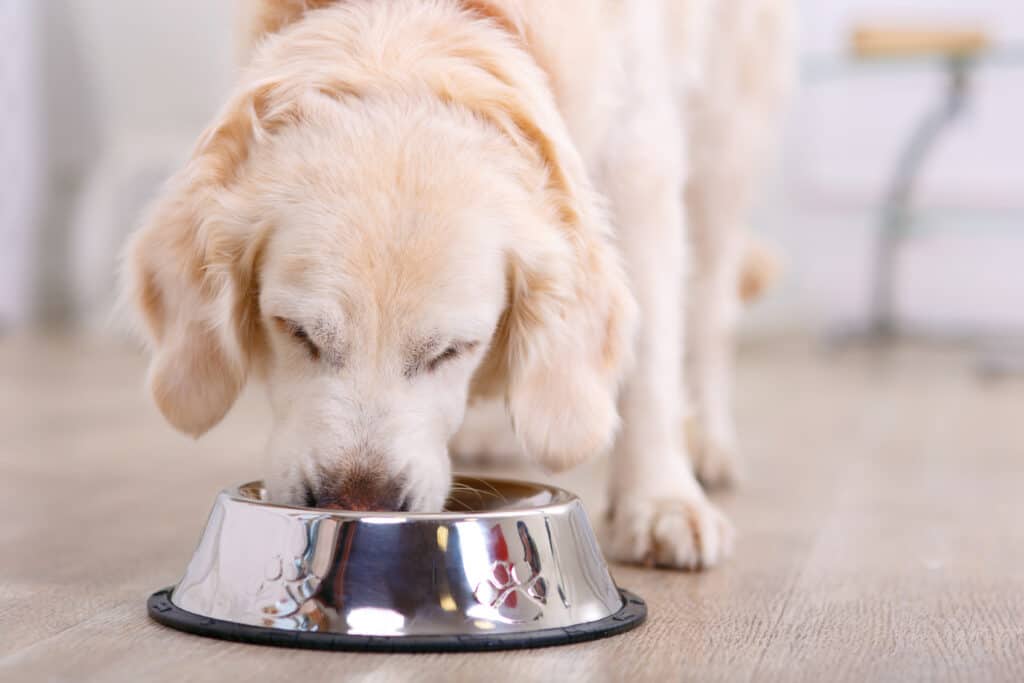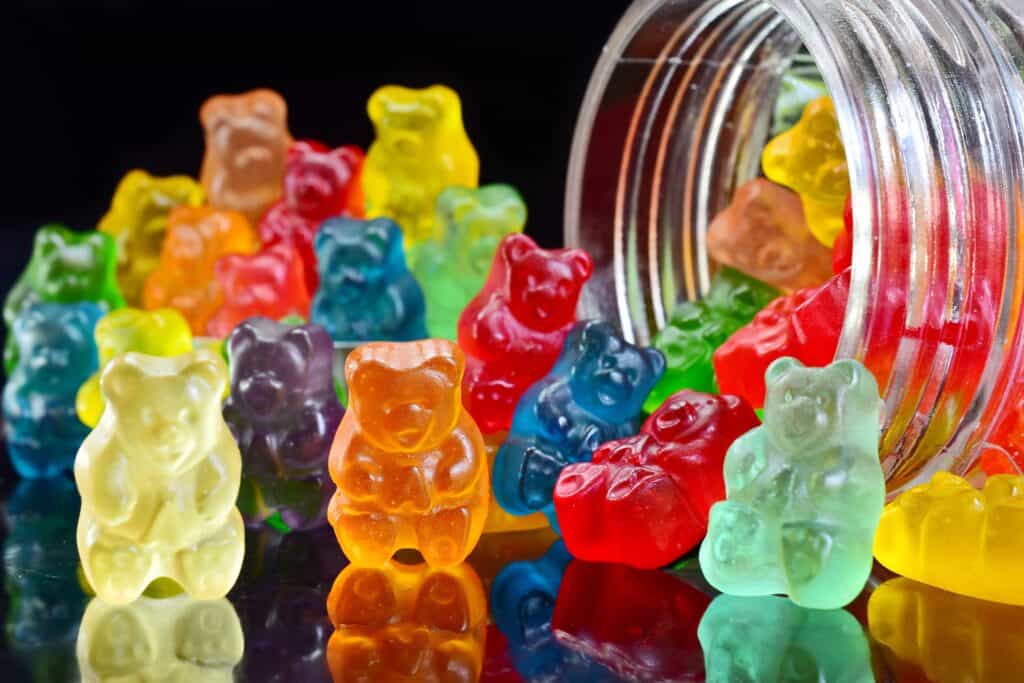Can dogs eat gummy bears? Gummy bears are a childhood and movie theater favorite. As a kid, you may have begged for a bag from your parents. Kids and adults go crazy over these gummy treats. What are in these magical treats, though? A combination of glucose syrup, sugar, starch, food coloring, flavoring citric acid, and gelatin are used to make the classic gummy bear.
However, recipes differ because some people couldn’t have the original ingredients. They became more accommodating to those who wished to enjoy the treat, resulting in many variations. You may be curious if you can share a few gummy bears with your dog, or maybe your dog has snagged a few from your bag!
Either way, it’s great to know how your pup may be affected by trying something new. Your dog shouldn’t eat these treats, and you’ll learn more about why they shouldn’t. In this post, we’ll talk about how each ingredient can affect your pup and what to do if they eat some.
How the Ingredients Affect Dogs

In general, food coloring is typically safe for dogs. However, some dogs may have an allergy and get sick.
©Dmytro Zinkevych/Shutterstock.com
Dogs react differently to gummy bears than humans do because their bodies aren’t the same. Some of the ingredients mentioned are basic food and flavoring additives. Food coloring should be safe for dogs as long as the FDA has approved it. Although allergies to food colorings in dogs are uncommon, they can occur. It can upset their stomach.
However, food coloring and flavoring shouldn’t cause an issue. In this section, we will go over each ingredient found in gummy bears and how it can affect your dog. You’ll be able to know for future reference when checking other foods that you may want to give your dog. It can also help you to know which ones to keep out of reach from them.
Glucose syrup
Glucose syrup is used mainly in preparing commercial foods as a sweetener, thickener, and moisture-retaining agent. It is frequently used to produce candy and several prepackaged baked foods because it doesn’t crystallize. Glucose syrup is not the same as glucose. Glucose is a simple carb and the preferred fuel for your body and brain.
Instead, the syrup is created by hydrolyzing the glucose molecules in starchy meals. This chemical reaction results from a concentrated, sweet, and highly glucose-containing substance. This syrup has a high sugar content and is not advisable for your dog, even though it is not harmful in small amounts.
Sugar

Sugar can be harmful to your dog, as it can contribute to weight gain and obesity, heart disease, elevated blood sugar, diabetes, gum disease, and tooth damage.
©Nestor Rizhniak/Shutterstock.com
Overindulging in sugar can be difficult on your pet’s digestive system, and an upset stomach is most likely to be the first sign. Acid reflux, bloating, vomiting, and diarrhea are possible in your dog. If sugar is consistently offered to dogs, they may also experience longer-term health issues.
Weight gain, obesity, elevated blood sugar, diabetes, and heart disease are a few of them. The systemic inflammation caused by sugar also includes the pancreatic inflammation known as pancreatitis, which can be fatal to dogs. Too much sugar can cause gum disease and tooth damage. Sugar can be a food source for harmful oral bacteria, which can then produce acids that erode tooth enamel and inflame the gums.
Starch
One of the main sources of dietary energy for people is starch, a type of carbohydrate that is frequently found in nature. It is commonly consumed in the form of the staple foods that are grown all over the world, such as wheat and potatoes.
Starch is one of the three major types of carbohydrates, along with fiber and sugar. As long as they don’t make up the majority of the dog’s diet, carbohydrates are not harmful to dogs. Weight gain and digestive issues can result from eating too many carbohydrates.
Citric Acid
One of the most popular flavor and food preservation ingredients is citric acid. Citrus fruits naturally contain it, although it is also produced. Its name comes from the organic acid that it is, which is present in many fruits and vegetables, particularly citrus fruits.
Concentrated powdered citric acid is valued for its sour flavor, ability to preserve foods, and function as a pH buffer. Citric acid is listed as an ingredient in many dishes in your kitchen for these reasons. Experts in food and nutrition view this element as a natural functional substance that, at worst, is benign to the health and wellbeing of pets.
Gelatin
Gelatin is a protein that can be made by boiling bones, skin, tendons, and/or ligaments in water. It is often derived from pigs or cows. Dogs can eat gelatin, and some experts even recommend it for them, but you shouldn’t give them any that includes xylitol. Additionally, you shouldn’t give them sugar-free Jell-O because dogs shouldn’t consume artificial sweeteners.
Risks

Gummy bears are often made with artificial sweeteners, which are toxic to dogs.
©Nodar Chernishev/Shutterstock.com
Regular Gummy bears may not be immediately poisonous, but they are high in sugar and could upset your dog’s stomach. Unfortunately, this is only the very beginning. Gummy bears and other candies are now offered in sugar-free varieties. These formulae might include xylitol, a highly hazardous artificial sweetener for dogs.
Xylitol only needs to be consumed in trace amounts to be toxic. It may be lethal to a dog if the amount is great enough. The pancreas releases insulin, which in turn regulates blood sugar levels. In people, xylitol does not cause the pancreas to release more insulin.
However, when consumed by dogs, xylitol is quickly absorbed into the bloodstream, which causes a powerful insulin release from the pancreas. This quick insulin release results in a severe drop in blood sugar (hypoglycemia), which can happen around 10 to 60 minutes after eating. Hypoglycemia can be fatal if left untreated. Uncertainty surrounds the mechanism by which xylitol can result in liver failure in dogs.
Conclusion
So, can dogs eat gummy bears? While some gummy bears may not be toxic, avoiding them is still best. If your dog got a hold of the sugar-free version, take them to the emergency vet clinic right away. Several dog treats are available that offer health benefits and make excellent treats for your dog. Treat them with those. And always be sure to give your dog good quality dog food on a regular basis as well.
Keeping gummy bears out of your pup’s reach is vital, so you don’t have any frantic trips to the vet. Regular gummy bears can cause diarrhea if eaten in excess, which will make your dog feel ill and cause them to have diarrhea.
No one enjoys cleaning that up, and the best thing to do is to avoid gummy bears altogether. Please keep your dog healthy by checking out our other posts on what dogs can eat. Share this article with a dog owner who loves gummy bears!
Up Next:
- Can Dogs Eat pumpkin Pie? Mostly No, But Sometimes Yes
- What Foods Can Dogs Eat Safely, and Which Are Dangerous?
- Can Dogs Eat Pickles Safely? It Depends
- 5 Nuts Your Dogs Can Eat Safely, and 4 to Avoid
- Can Dogs Eat Mint? What Are the Risks?
The photo featured at the top of this post is © iStock.com/damedeeso
Ready to discover the top 10 cutest dog breeds in the entire world?
How about the fastest dogs, the largest dogs and those that are -- quite frankly -- just the kindest dogs on the planet? Each day, AZ Animals sends out lists just like this to our thousands of email subscribers. And the best part? It's FREE. Join today by entering your email below.
Sources
- Great Pet Care, Available here: https://www.greatpetcare.com/dog-nutrition/can-dogs-eat-gummy-bears/#:~:text=While%20gummy%20bears%20and%20gummy,a%20large%20amount%20of%20sugar.
- Hepper Blog, Available here: https://www.hepper.com/can-dogs-eat-gummy-bears/
- Cuteness, Available here: https://www.cuteness.com/13728058/can-dogs-eat-gummy-candy
- Veterinary Formulated CBD: Helping Your Pet Thrive, Available here: https://vetcbdhemp.com/blogs/articles/can-dogs-eat-gummy-bears
Thank you for reading! Have some feedback for us? Contact the AZ Animals editorial team.






